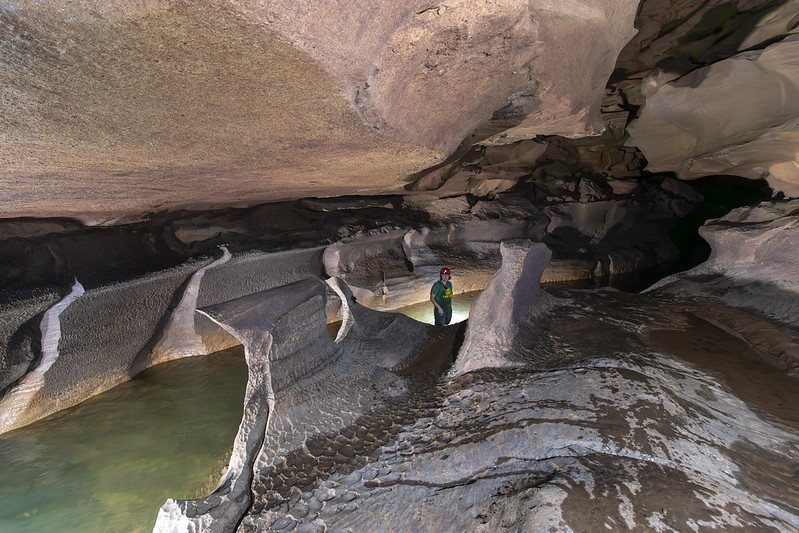Capshaw Cave

Much of Capshaw Cave looks like the above image; subway tunnel passages following meanders of a cold underground river. The floor of the cave is generally gravel, sometimes clean washed and scalloped limestone, sometimes tires and trash. The urban nature of the cave has left it largely devoid of the kind of life one would expect to find in a wet cave of this size. You will find no cave crayfish, no southern cave fish, and no bat species that call Capshaw Cave home.
Today I am assisting TTU geology professor Evan Hart with data collection in the cave. Banks of sediment left behind from floods tell stories to those who listen. Evan's tools include a shovel, plastic siding, toilet paper, and tape. With the "U" shaped plastic siding he removes cross sections of sediment. Looking at the cut he dug with the shovel it's clear there is a story. Finely laminated alternating beds of sand and silt seem to show periods of higher energy and lower energy. The bigger story will require more work.

"More," Evan says as I hand him another wad of toilet paper. He packs it atop the soil sample to preserve its structure. When we've packed it in, it then gets wrapped in tape, labeled, and stored in his backpack to be taken from the cave. The technique of preserving stratigraphic sections was something he learned from a recent correspondence with archaeologist Sarah Sherwood at the University of the South. She applies it towards rock shelters that Native Americans once inhabited. Here, we are looking at the history of water in this part of Cookeville.
While Evan works on preparing his samples, I take my photography team and wander a short distance to take a few photos. I know I can take a photo, turn 180 degrees and take another photo and for my audience it may as well be miles apart from the previous shot. It's a truth that all caves look the same, but caves all also look different. I don't know if I can explain that, sometimes it is best to let the photos do the talking.

We are moving again. I'm trying to keep up with long-legged Evan whose strides seem to cut the water. My boots, while being great at protecting my feet in a cave environment, are both naturally heavy, and are currently filled with water. One of us is a dancer, the other is a snow plow. We never go far between places to take photos or samples though.
In moments I'm barking orders to my photo team. "Luke, grab two flashes." "Annabelle, stand over by my finger's shadow" as I wiggle a finger in front of my headlamp to show her where to go. Communication is difficult in cave photography. Lots of things need to happen, and if they don't happen quickly morale fails and folks get bored of working with me. In a wet cave this issue is compounded. Every moment we're stopped we're not generating heat to offset the cooling effect of the 55 degree water we're standing in. Despite this, I coax Luke into wading chest deep into the creek for a photo. A flash fired down into the water produces an pleasing blue glow around the subject. "That looks great. Pack it up," I say. Sometimes I'll make "wow" sounds and invite them over to see the finished product. Generally I let it ride. In a few days they will see themselves on Facebook.

A few more sites for sediment and photo collection and we find ourselves making the free climb through a waterfall, and then out of the cave. We emerge, wet and cold into the frigid winter air.
Comments
Grade-5 cartography as NSS 8275-RE. Not only saw entire cave but
private property houses located over it. The house I owned then
was in East Nashville for state employment reasons. Present NSS-
RL member of the Wyoming Grotto but reside by the Salish Sea. .
Per the toxic land owner. At the time I was a paid NSS
member o the San Francisco Bay Chapter and the Nashville
Grotto. My present exploration occurs in limestone of the
Permian Age and is 5 miles NW of an active Volcano caldera.